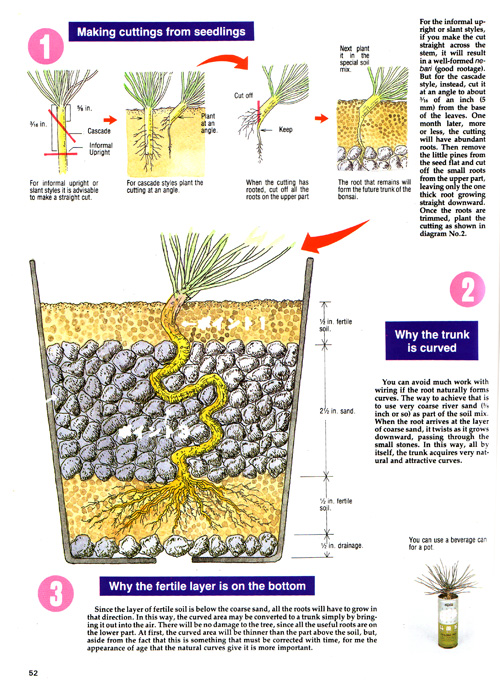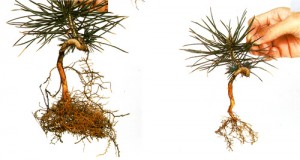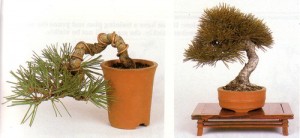
A unique technique
The illustrations and photos used here are from an article by Kusida Matsuo that originally appeared in Bonsai Today issue 20 (out of print). The unique technique featured is for shaping cuttings taken from seedlings. Though Japanese black pine are used here, the technique should work on any number of species.
A little help
Because the type with the illustrations is so small, I’ll provide a brief review of the steps involved.
Part 1
The first drawings (upper left) show: First; two ways to take cuttings: straight for informal upright and slanting trees and at an angle for cascading trees. Second; planting angles. Third; on the angled planting (for cascades) cut off the upper roots and save the roots growing down off the bottom of the cutting. Forth; planting in the special layered soil mix.
Part 2
The large drawing gives a pretty good view of the heart of the technique. The top 1/2″ (1.25cm) is regular (fertile) soil. The next layer is 2 & 1/2 inches of very coarse river sand. Below that is another 1/2″ layer of fertile soil and below that a coarse drainage layer.
Part 3
The main root (the future trunk) grows through the coarse sand and into the fertile layer below where new roots can grow. After one year, the plant is removed. The root section that grew through the coarse sand becomes the new trunk.

One year later
This shows a cutting one year later when it is removed from the special layered soil mix before it’s potted in regular soil. Left; before root pruning. Right; after the roots growing off the trunk have been removed and the bottom roots have been pruned.

Six years later
A couple trees that were grown using the technique. Six years from cuttings.
This is an interesting technique, but I have one question. Does budding occur along the part of the tree that once was root to assist in thickening the trunk base?
Trunks that were once roots are no different than other trunks. Some types of trees back bud easily (most deciduous, most tropicals, azaleas etc), while some, like most pines, tend to bud only at, or near, the tips of branches.
Does this help?
Wayne this has not been my experience. Only my Quince and Wisteria have sprouted shoots from their bases – hence, the reason I am asking this question. I have had a Chinese elm, Trident Maple, an Azalea and a Kingsville Boxwood for years, all in the neagari style, and none of them have budded back on their root system-based “trunks.” I just want to know if anyone has a method of stimulating ramification along an area of a tree that once was root (but I am not talking about trees that have rhizomes, stolons or other means of spreading below the surface of their growth media).
I guess some do and some don’t. The one the surprises me the most is the azalea, which buds prolifically, particularly after pruning. Which begs the question; have you tried hard pruning to force back budding?
Perhaps someone else out there has some experience that might shed some light?